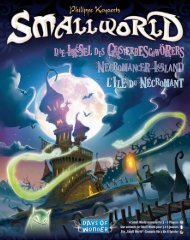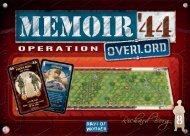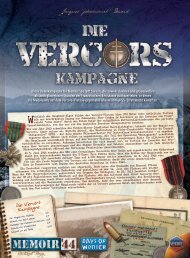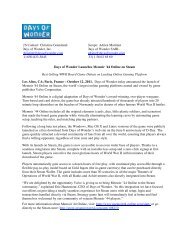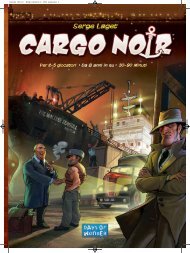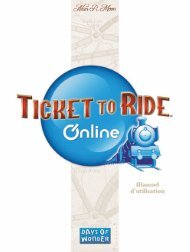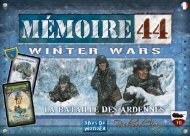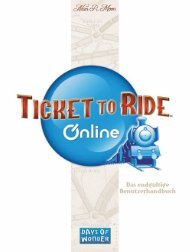Ticket to Ride Europe - Rules - Days of Wonder
Ticket to Ride Europe - Rules - Days of Wonder
Ticket to Ride Europe - Rules - Days of Wonder
Create successful ePaper yourself
Turn your PDF publications into a flip-book with our unique Google optimized e-Paper software.
LocomotivesLocomotives are multi-colored, and act as wild cards in the game.Locomotive cards can be played along with any set <strong>of</strong> cards when claiming a route. They are also vital <strong>to</strong> claimingFerry routes (see Ferries).If a face-up Locomotive card is picked during a card draw, it must be the only card picked that turn. If a Locomotive is turned over as a replacementfor a first card drawn during the turn, or if a Locomotive is available face-up but not picked up as the first (and only) card, it cannot be selected asa second card.However, if a player is lucky enough <strong>to</strong> get a Locomotive from the <strong>to</strong>p <strong>of</strong> the deck in a blind draw, it still counts as a single card and he may still drawa <strong>to</strong>tal <strong>of</strong> two cards that turn.Claiming RoutesA route is a set <strong>of</strong> continuous colored spaces (in some instances, grayspaces) between two adjacent cities on the map. To claim a route, a playermust play a set <strong>of</strong> Train cards whose color and quantity match the colorand number <strong>of</strong> spaces <strong>of</strong> the chosen route.Most routes require a specific set <strong>of</strong> colored cards <strong>to</strong> claim them.Locomotives can always act as a stand-in for any given color (Seeexample 1).Routes that are Gray can be claimed using a set <strong>of</strong> cards <strong>of</strong> any one color(See example 2).When a route is claimed, the player places one <strong>of</strong> his plastic trains oneach <strong>of</strong> the spaces <strong>of</strong> the route. All the cards from the set used <strong>to</strong> claimthe route are then discarded. The player then immediately records hisscore by moving his Scoring Marker the appropriate number <strong>of</strong> spacesalong the Scoring Track, per the Route Scoring Table on page 7.A player may claim any open route on the board. He is never required <strong>to</strong>connect <strong>to</strong> any <strong>of</strong> his previously played routes.A route must be claimed in its entirety during a single turn. For example,you cannot lay two trains on a three-space route and wait for the nextturn <strong>to</strong> lay the third train.No more than one route may be claimed in a given player’s turn.Example 1orororTo claim a Blue route that is threespaces long, a player may play any<strong>of</strong> the following card combinations:three Blue cards;two Blue cards and a Locomotive;one Blue card and two Locomotives;or three Locomotives.Example 2ororA Gray route that is Two spaceslong can be claimed by playingtwo Red cards;one Yellow card and a Locomotive;or two Locomotives.Double-RoutesDouble - RoutesSome cities are connected by Double-Routes. These are routes whose spaces are parallel and equal innumber from one city <strong>to</strong> the other. One player can never claim both routes between the same cities duringthe course <strong>of</strong> the game.Be aware <strong>of</strong> routes that are partially parallel <strong>to</strong> each other but are linked <strong>to</strong> different cities. These arenot double-routes.parallel routesImportant Note: In two or three player games, only one <strong>of</strong> the Double-Routes can be used. A player can claim either<strong>of</strong> the two routes between cities, but the other route is then closed <strong>to</strong> the other players for the remainder <strong>of</strong> the game.4




